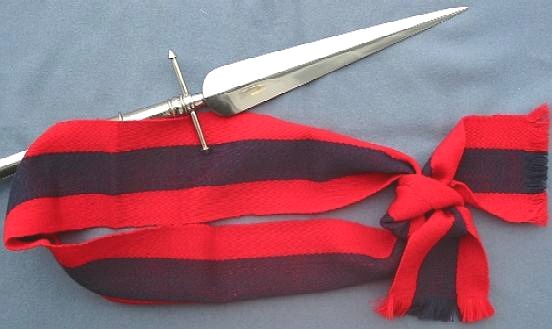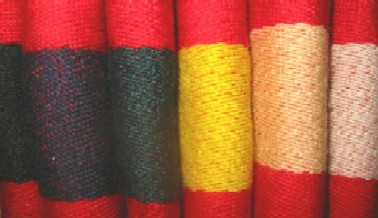
 |
|
| |

SOLD OUT
# MIS046
Length is 72 inches (suitable for
Highlanders as well).
Historical
The first mention of infantry sergeant's sash with a single stripe of facing colour in the British Army came in the clothing regulations of 1727. Regulations were vague on whether it was to be worn over the shoulder or around the waist. This was clarified in 1747 when orders were issued calling for sergeants to always wear their sashes around their waists. With the exception of highland regiments, from this point until 1826, the serjeant's sash changed very little.
However there were deviations from regulations from time to time. For example in the 1790s some regular regiments issue solid crimson sashes to their men (made of cheaper floss silk) . This distinction was reserved for the Guards and Ordnance Corps and military officials in 1799 found it necessary to restate the regulations to the regiments. In the order it was specifically stated that red faced regiments will wear a sash with a white stripe. This singling out gives the impression the red faced regiments were the principal ones bending the rules. Even with that, recruiting sergeants are often depicted with the more showy solid crimson sash, along with ribbons in the shako, to give them a dressy edge to dazzle perspective recruits into serving king and country.
In 1802 they did make an attempt was made to regulate the length. However none of the originals that have survived are of this regulation, nor does pictorial evidence bear this out. In fact it appears these pattern was sleeved until the next regulation change came along 24 years later.
The single stripe serjeant's sash was replaced in 1826 with a three strip sash with cords made in the same fashion as light infantry officer sashes. Nineteen years later this pattern gave way to an all-crimson wool girdle sash with hook and eyes and no knot, tassels or fringe. Facing colours in the sergeant's sash disappeared.
Construction
Historically this sash was made by a technique called spranging. The result was much like a netting that could widen and contract. To do this many metres of woolen cord were placed on a special spranging machine. Often these machines were made two stories high running through the floor to the lower level.
The idea of having this net construction was that if an officer was wounded on the field his sash could be used as a stretcher. The original purpose of the officer sash's contruction started to lose its meaning when the sash went from the should to the waist in 1768. The length was gradually reduced for convenient wearing.
Since the sash of the sergeants was to be worn around the waist, its length was greatly reduced from the outset. It is obvious from the various lengths of surviving sashes, they were intended to go around the waist once. However they were spranged like the officer sashes. There were a number of variations: some had fixed knots while others finished with fringe frayed or knotted of.
Unfortunately today spranging is a dying technique and most if not all the old industrial spranging machines have disappeared. Even if the technique could be economically reproduced, the materials alone, namely the unique cording material, in each sash would cost hundreds of dollars. We attempted spranging the sash from just strands of yarn but appearance deviated measurably from its original appearance.
Therefore we have produced with success a hand-woven wool sash to mimic the contracted state of spranging. It's length of 72 inches is designed to pass around the body or over the shoulder for highland regiments, and the width measurements are from an original sash, as it would have been when tied around the waist. We chose the frayed fringe (ends of sash called tags). The quality of the hand weaving is simply excellent and a great deal of thought and care has gone into this replica. According to regulations Infantry sergeants were to tie the knot of their sashes on the left, but during the Napoleonic period there were numerous deviations to this rule. Cavalry sergeants wore them on the right, but this was not universal. The knot was worn slightly to the front above the knee so it did not impede the carrying of the halberd or pike. - Robert Henderson
Facing
Colours Available:
(left to right) Black, Navy Blue,
Green, Yellow, Buff, and White

- Click Here for FAX Order Form -
- How to Contact Us
-
© Copyright 1995-2023: Unless otherwise noted, all information, images, data contained within this website is protected by copyright under international law. Any unauthorized use of material contained here is strictly forbidden. All rights reserved. Access Heritage Inc (formerly The Discriminating General) is in no way to be held accountable for the use of any content on this website. See Conditions of Use.